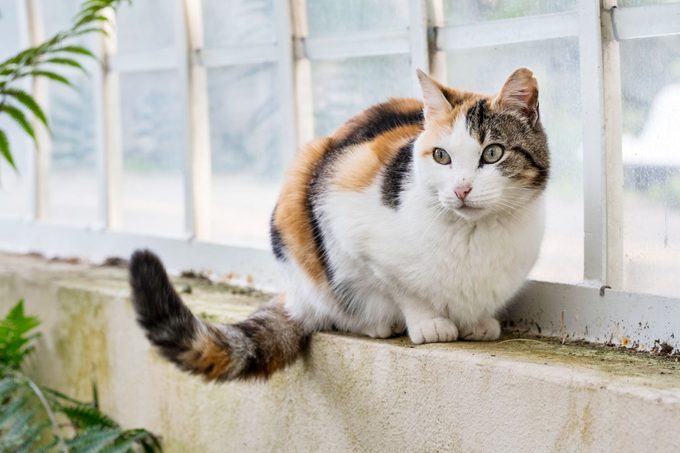Our feline friends say a lot with their body language. Here's why cats wag their tails, according to an expert.

Why Do Cats Wag Their Tails? A Cat Behavior Expert Explains

Cats are mysterious little creatures, known for leaving even the most devoted pet parents utterly stumped. One minute, they’re curled up in their fluffy cat tower, and the next, they’re kneading like they’re the employee of the month at a biscuit factory or rubbing against your leg like they’re trying to send you a secret message. But perhaps the most puzzling question of all: Why do cats wag their tails like dogs? And does it mean the same thing?
Science says that when your favorite feline’s tail starts moving, there’s a reason for each motion. Whether it’s straight and pointing upward, tucked between the legs or slowly wagging, a cat’s tail tells many tales. Of course, decoding cat behavior solely based on tail movement may require a little assistance for new and experienced pawrents alike.
To help you out, we spoke with Mikel Maria Delgado, PhD, a certified cat behavior consultant and animal behaviorist, who translated this common cat body language. Read on to really understand what it means when cats wag their tails.
Get Reader’s Digest’s Read Up newsletter for more pets, tech, travel, cleaning, humor and fun facts all week long.
Do cats wag their tails just like dogs?
No, there’s a clear difference between the way dogs wag their tails and the tail motions feline owners are familiar with, says Delgado. “We usually refer to cats as swishing their tails, as the movement is not quite the same as a dog’s wagging tail,” she says. “The meaning of the tail movements can be quite different in cats.”
Why do cats wag their tails?
“In general, a cat swishing their tail is indicating some level of excitement, which can be good or bad, depending on the circumstances,” says Delgado. “Some cats are also just more ‘swishy’ in general, so it’s good to observe your cat carefully when they are swishing their tail to help you determine how they might be feeling.”
The first step, according to our expert, is to brush up on cat body language. It helps to know, for example, how cats show they’re secretly mad at you or even when they’re feeling depressed. And while there’s no one-size-fits-all body language cheat-sheet, understanding the signals gets you one step closer to figuring out what your pet, in particular, is trying to say.
Ready to zero in on your furry friend’s behavior? The following scenarios can help explain why cats wag their tails.
Why do cats wag their tails when lying down?
All cat owners have seen this before: While lying down, your kitty is swishing its tail, slowly and often with a climbing pace. The reason cats wag their tails like this is tough to decode—it really depends on the circumstances, Delgado says.
The movement could be a call for some pets … or a subtle warning not to disturb their peace. “But since it generally indicates some level of excitement or arousal, it would suggest that the cat is not totally relaxed,” she says. “They might be conflicted: Maybe there’s an irritating sound or they want attention, but only in a specific way.”
So if your cat’s tail starts wagging while it’s lounging in a designated chill zone, hold off on the kiss attack (at least at first). If your cat stays relaxed, feel free to turn up the affection.
Why do cats wag their tails while being pet?
We’ve got a clearer answer for this question: If your cat is moving its tail back and forth while you’re petting it, it could be overstimulated, says Delgado.
“[It could mean] that he is starting to become irritated from petting,” she explains. “It could also be where you are petting them, or it could be that they have just had enough of petting in general. I would give your cat a break from petting if they are tail-swishing when handled.”
So is a cat wagging its tail good or bad?

Ask five pet behaviorists, “Why do cats wag their tails?” and you’ll get the same answer: to communicate.
“You should use that information to help you understand how your cat is feeling,” Delgado says. “If they are staring out the window at another cat and swishing their tail, they may be frustrated or excited. If you are petting them and they swish or wag their tail, it likely means they are irritated.”
In short, it’s all about observing your cat, picking up on clues and being aware of situational factors.
“Keep in mind: You can’t just go by the tail,” she warns. “Look at what is going on in the environment, and look at your cat’s entire body language. Do they seem relaxed? Are they blinking their eyes, laying stretched out, purring or kneading? Are they tense with a tight body that is hunched up? Are they worked up with puffed fur and vocalizing? Those clues can help you better understand what your cat’s tail swish means.”
Cats, like their humans, are complex beings, so treat them as such. “Just like us, cats can have mixed feelings or change opinions quickly,” Delgado says. To understand your furry friend, paying wholehearted attention to it is the ultimate bottom line, whether it’s wagging its tail or knocking things over.
About the expert
|
Why trust us
At Reader’s Digest, we’re committed to producing high-quality content by writers with expertise and experience in their field in consultation with relevant, qualified experts. We rely on reputable primary sources, including government and professional organizations and academic institutions as well as our writers’ personal experiences where appropriate. We verify all facts and data, back them with credible sourcing and revisit them over time to ensure they remain accurate and up to date. Read more about our team, our contributors and our editorial policies.
Source:
- Mikel Maria Delgado, PhD, certified animal behaviorist and certified cat behavior consultant with Rover























